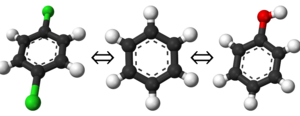Difference between revisions of "Exponential Averaging"
(Created page with "{{fundamentals | cTopic=Theory}} Exponential Averaging (EXP) is one of the earliest free energy methods available to researchers. Mostly used to evaluate between only two states ...") |
|||
| Line 3: | Line 3: | ||
=Derivation= | =Derivation= | ||
| + | Starting from the statistical relation for free energy of | ||
| + | |||
| + | :<math> \displaystyle A = -\beta^{-1} \mathrm{ln}\, Q</math> | ||
| + | |||
| + | the free energy difference between two states with potentials <math>U_0(\vec{q})</math> and <math>U_1(\vec{q})</math> is simply | ||
| + | |||
| + | :<math> \displaystyle A_1 - A_0 = -\beta^{-1} \left[\mathrm{ln}(Q_1) - \mathrm{ln}(Q_0)\right] = -\beta^{-1} \mathrm{ln}\left[\frac{Q_1}{Q_0}\right] </math>. | ||
| + | |||
| + | By then adding and subtracting <math>e^{-beta U_0(\vec{q})}</math> from the numerator, we get | ||
| + | |||
| + | :<math> \Delta A_{10} = -\beta^{-1} \mathrm{ln} \left[\frac{\int e^{-\beta \left(U_1(\vec{q})-U_0(\vec{q})+U_0(\vec{q})\right)} d\vec{q}}{Q_0}\right] = -\beta^{-1} \mathrm{ln} \left[\frac{\int e^{-\beta \left(U_1(\vec{q})-U_0(\vec{q})\right)} e^{-\beta U_0(\vec{q})} d\vec{q}}{Q_0}\right]</math> | ||
| + | |||
| + | which gives the final relationship of: | ||
| + | |||
| + | :<math> \displaystyle \Delta A_{10} = \beta^{-1} \mathrm{ln} \left\langle e^{-\beta \left(U_1(\vec{q})-U_0(\vec{q})\right)} \right\rangle_0 = \beta^{-1} \mathrm{ln} \left\langle e^{-\beta \Delta U(\vec{q})} \right\rangle_0 | ||
Revision as of 13:46, 13 September 2012
| Free Energy Fundamentals |
|---|
 |
|
Methods of Free Energy Simulations
|
| Free Energy How-to's |
|---|
 |
Exponential Averaging (EXP) is one of the earliest free energy methods available to researchers. Mostly used to evaluate between only two states of interest, it has an exact solution where as many others require approximations. Other names for this technique are the "Zwanzig Relationship" (named after the person who derived it) and "free energy perturbation (FEP)." To avoid confusion, the later term should be avoided as it can easily be confused with other definitions in the scientific field.
Derivation
Starting from the statistical relation for free energy of
- [math]\displaystyle{ \displaystyle A = -\beta^{-1} \mathrm{ln}\, Q }[/math]
the free energy difference between two states with potentials [math]\displaystyle{ U_0(\vec{q}) }[/math] and [math]\displaystyle{ U_1(\vec{q}) }[/math] is simply
- [math]\displaystyle{ \displaystyle A_1 - A_0 = -\beta^{-1} \left[\mathrm{ln}(Q_1) - \mathrm{ln}(Q_0)\right] = -\beta^{-1} \mathrm{ln}\left[\frac{Q_1}{Q_0}\right] }[/math].
By then adding and subtracting [math]\displaystyle{ e^{-beta U_0(\vec{q})} }[/math] from the numerator, we get
- [math]\displaystyle{ \Delta A_{10} = -\beta^{-1} \mathrm{ln} \left[\frac{\int e^{-\beta \left(U_1(\vec{q})-U_0(\vec{q})+U_0(\vec{q})\right)} d\vec{q}}{Q_0}\right] = -\beta^{-1} \mathrm{ln} \left[\frac{\int e^{-\beta \left(U_1(\vec{q})-U_0(\vec{q})\right)} e^{-\beta U_0(\vec{q})} d\vec{q}}{Q_0}\right] }[/math]
which gives the final relationship of:
- <math> \displaystyle \Delta A_{10} = \beta^{-1} \mathrm{ln} \left\langle e^{-\beta \left(U_1(\vec{q})-U_0(\vec{q})\right)} \right\rangle_0 = \beta^{-1} \mathrm{ln} \left\langle e^{-\beta \Delta U(\vec{q})} \right\rangle_0